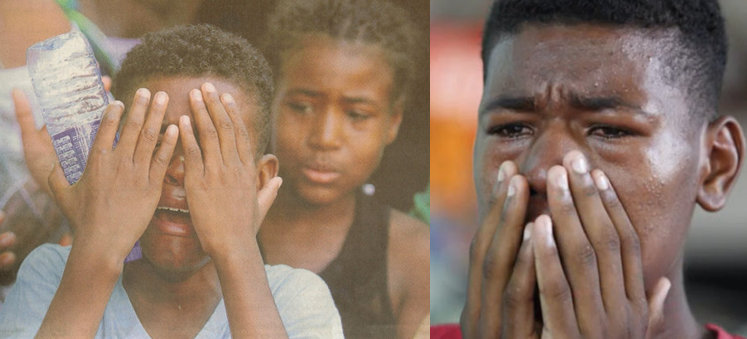For Cláudia Silva Ferreira: Death and the Collective Black Female Body
By Guest Contributor on May 5, 2014By Christen Smith
What do we want from each other After we have told our stories do we want to be healed do we want mossy quiet stealing over our scars… – “There Are No Honest Poems About Dead Women” – Audre Lorde “Every police car has a bit of slave ship in it” – O Rappa
****
On March 16, 2014, military police in Rio de Janeiro shot and severely wounded Cláudia Silva Ferreira near her home while she was on the way to buy cold cuts and bread. The police officers were in a gunfight with alleged drug traffickers, and they shot her twice – “stray bullets.” Although she was already severely wounded, the police waited until the fight was over to put her in the hatchback trunk of the police car to take her to the hospital. Then, on the way to the hospital, she fell out of the trunk, but they did not stop the car. The officers continued to drag her behind the police car for 250 meters until they reached a red light, where they stuffed her limp body back inside. As I watched the video it took me a long time to process what I was seeing. I don’t know if it was the grainy quality of the image shot behind a car window, my dizziness from hurt, nausea and anger, or my cognitive refusal to witness a black woman, mother of eight (four biological children and four nieces and nephews she and her partner were raising), wife, friend, neighbor, being dragged along the street behind a police car. In broad daylight. In the middle of a busy thoroughfare. Her body limp and doubled, dragging, hanging from the trunk by her clothing. Her bare legs scraping across the ground. I did not want to watch. I still do not want to watch. I want to close my eyes and make it all go away. But each time I close my eyes all I can see are the black women like her who have been similarly if only symbolically dragged by the state across time and space: Laura Nelson, Eleanor Bumpers, Aiyana Stanley-Jones, Renisha McBride. How could they not see her? No, I know that they knew she was there, I mean how could they not see her. How can they not see us? The police officers in the car heard the people on the streets screaming for them to stop. They kept going. Two police officers got out of the car at the next red light. Picked up her body, and threw her back in the hatchback trunk. They kept going. They took her to the hospital. Dead on arrival. A “false police rescue.” She was alive when the stuffed her in the trunk of the car after “stray bullets” struck her in the neck and back at close range.[i] She was on her way to pick up $3 worth of bread and bologna for her kids. They were hunting drug dealers. She looked like their prey, despite the fact that the neighbors screamed and pleaded, “she is a hard-working, honest woman, don’t shoot.” They did it anyway. They wouldn’t let her family come with her to the hospital. They put her in the back of the car “like a common criminal.” They dragged her so far that her legs were raw by the time she arrived at Carlos Chagas State Hospital. A slow long death alone. Dead on arrival. “They dragged my mother like a bag and threw her into the car like an animal.” Thaís Silva (18) was the first one to see her mother arrive “lifeless” at the hospital. As black women, ours is often the flesh that the state uses to fertilize the nation; consolidate its power. On the pretenses of public safety, they invade our neighborhoods and our homes, pull us out and kill us, spilling our blood into the pavement. I am tired of them dragging us limp and lifeless through the streets on alleged missions to save us. They grind us into the road oblivious to our life’s worth and impervious to the unspeakable pain that they inflict on our children, our partners, and the loved ones we leave behind. Violence against black women is a global, communal, generational violence. As a black woman I am painfully aware that anywhere and almost everywhere I go I am a target for white supremacist heteropatriarchy, and it is often the state that exacts this violence. Our bodies are always marked as violable. Yet oftentimes in our discussions of state violence, we neglect to account for the fact that black women are always the intended targets of anti-black state terror, even when the ones who are killed are black men. And racial states, like Brazil (although Brazil is not exceptional), depend on the spectacular torture and killing of our bodies in order to consolidate the nation. The three police officers from the 9º BPM unit (Rocha Miranda) did not mistake Cláudia Ferreira for a drug dealer when they invaded her neighborhood of Madureira and shot her; she was their intended target, even if they did not know her by name or even know that she existed before they stormed her community. There are two things that particularly strike me about the death of Cláudia Ferreira. The first is that her death was not simply a national moment, but rather a transnational racial eruption. The second is that hers was a collective death, not an individual one. We cannot separate the police raid on Madureira and Cláudia Ferreira’s shooting and dragging death from Brazil’s increased efforts to “clean up” the streets of its main tourist hot-spot – Rio de Janeiro – in anticipation of this summer’s World Cup and the impending 2016 Olympics. Throughout Brazil’s major urban cities, state governments have organized Pacifying Police Units – UPP[ii] in order to attempt to “clean up” crime and “pacify” violence in Rio’s favelas in anticipation of these two global mega sporting events. The result has been an escalation of state terror against majority black working class communities like Madureira. Brazil’s favelas have become occupied territories where police violence is a daily reality. And although the intended purpose of this violence is to root out drug dealers and eliminate gang violence, far too often “drug trafficker” is just a code word for poor black person. And many people who have no connection to drug trafficking are killed every day, only to be criminalized post-mortem in order to justify these killings. Cláudia Ferreira’s death was a state performance enacted for the global stage. As such it was much more than just a national act (it exceeded the boundaries of Brazil). Yet beyond these immediate and urgent circumstances, there is a deeper question at play. Namely, the repeated spectacular gendered killing and torture of working class black people in Brazil’s urban peripheries suggests that in fact the state depends upon performing violence against the black body in order to validate itself transnationally as a capable world power. In other words, in order for Brazil – a nation that the world is now looking to as a key emerging economy – to solidify its legitimacy as a heteropatriarchal state that dutifully upholds white supremacy (an acceptable space for the world to hold one of its biggest revenue-producing sporting events), it must publicly and spectacularly kill and torture black people. And black women are the preferred targets of this violence not because we are the ones most often killed, but rather because our death holds symbolic political meaning. As mothers, caregivers and gendered, sexualized political subjects, our deaths allow the state to perform its gendered, raced prowess.  If Cláudia Ferreira’s death was not a local, isolated moment of violence, but rather, a transnational one, then her death was also collective. When they dragged and killed Cláudia Ferreira, they dragged all black women and killed all black women. By making this statement, I am not attempting to appeal to some utopic vision of transnational black women’s solidarity that naively ignores the contours and effects of imperialism, classism, colorism, and heterosexism that diversify black women globally and confound our abilities to presume that we all share the same politics. Instead, I am reminding us that as black women, our physical bodies our unbound by our collective flesh. It’s not just that what happened to Cláudia Ferreira could have happened to us, it did happen to us, just as it happened to Laura Nelson, Eleanor Bumpers, Aiyanna Stanley-Jones, and Renisha McBride, not to mention others. Irrespective of our nationalities, we must always remember that the heteropatriarchal transnational state, defined by its investment in white supremacy, performs violence on our bodies in order to legitimate itself. We are always marked as violable and more importantly, we are always the prey. What changes is the address. Although the death of Cláudia Ferreira made headlines for weeks in Brazil, it was barely discussed here in the United States. A few websites covered it, but by and large the incident was dismissed. The relative lack of conversation, particularly among black feminists and black radical women in the U.S. disturbed me but did not surprise me. In many ways, we are often seduced by discourses of exceptionalism, which tell us that Brazil and other nations of the Global South are exotic, far away places where crazy things happen to other people. Questions of class and nationality often complicate our ability to recognize our political commonalities with black women outside of our immediate national, and linguistic (English-speaking) contexts. The death of Cláudia Ferreira reminds us that we are all implicated by these transnational acts of state terror, and we are all dragged behind them. The violence that we experience creates the very surface of our bodies and the boundaries of our worlds, melding us together emotionally and politically in uncomfortable ways. However, it is up to us not to let our experiences with violence be the only political terrain on which we define our collective identity. We must also speak up and speak out when we experience terror and pain inside and outside of our immediate material bodies.
If Cláudia Ferreira’s death was not a local, isolated moment of violence, but rather, a transnational one, then her death was also collective. When they dragged and killed Cláudia Ferreira, they dragged all black women and killed all black women. By making this statement, I am not attempting to appeal to some utopic vision of transnational black women’s solidarity that naively ignores the contours and effects of imperialism, classism, colorism, and heterosexism that diversify black women globally and confound our abilities to presume that we all share the same politics. Instead, I am reminding us that as black women, our physical bodies our unbound by our collective flesh. It’s not just that what happened to Cláudia Ferreira could have happened to us, it did happen to us, just as it happened to Laura Nelson, Eleanor Bumpers, Aiyanna Stanley-Jones, and Renisha McBride, not to mention others. Irrespective of our nationalities, we must always remember that the heteropatriarchal transnational state, defined by its investment in white supremacy, performs violence on our bodies in order to legitimate itself. We are always marked as violable and more importantly, we are always the prey. What changes is the address. Although the death of Cláudia Ferreira made headlines for weeks in Brazil, it was barely discussed here in the United States. A few websites covered it, but by and large the incident was dismissed. The relative lack of conversation, particularly among black feminists and black radical women in the U.S. disturbed me but did not surprise me. In many ways, we are often seduced by discourses of exceptionalism, which tell us that Brazil and other nations of the Global South are exotic, far away places where crazy things happen to other people. Questions of class and nationality often complicate our ability to recognize our political commonalities with black women outside of our immediate national, and linguistic (English-speaking) contexts. The death of Cláudia Ferreira reminds us that we are all implicated by these transnational acts of state terror, and we are all dragged behind them. The violence that we experience creates the very surface of our bodies and the boundaries of our worlds, melding us together emotionally and politically in uncomfortable ways. However, it is up to us not to let our experiences with violence be the only political terrain on which we define our collective identity. We must also speak up and speak out when we experience terror and pain inside and outside of our immediate material bodies. In her poem “For the Record,” written in memory of Eleanor Bumpers, Audre Lorde reminds us that we must “keep writing it down” and “keep telling this” even if it kills us “and it might in ways I am learning.” She goes on to remember that the day after Eleanor Bumpers was killed, Indira Ghandi was also assassinated, although in a different space, under different classed, raced, national circumstances. Lorde wonders if the two found each other, sisters, in the afterlife. Sometimes death is what links us together when we refuse or neglect to find each other in life. We must write honestly about our dead, and keep writing, even if it kills us. _________________________________________________
In her poem “For the Record,” written in memory of Eleanor Bumpers, Audre Lorde reminds us that we must “keep writing it down” and “keep telling this” even if it kills us “and it might in ways I am learning.” She goes on to remember that the day after Eleanor Bumpers was killed, Indira Ghandi was also assassinated, although in a different space, under different classed, raced, national circumstances. Lorde wonders if the two found each other, sisters, in the afterlife. Sometimes death is what links us together when we refuse or neglect to find each other in life. We must write honestly about our dead, and keep writing, even if it kills us. _________________________________________________  Christen Smith is a mother, writer, and researcher who works as an assistant professor of anthropology and African and African diaspora studies at The University of Texas at Austin. Her work explores the politics of performance, race, violence, and the body in the Americas. She has published essays on performativity and racial formation in Brazil, police violence and the politics of geography in Salvador, and the transnational collective black female body. Since 2001 she has been collaborating with Black organizers in Salvador, Bahia around the fight to denounce police violence and death squad actions against the Black community in Brazil. She is a member of the transnational grassroots community action organization Quilombo X.
Christen Smith is a mother, writer, and researcher who works as an assistant professor of anthropology and African and African diaspora studies at The University of Texas at Austin. Her work explores the politics of performance, race, violence, and the body in the Americas. She has published essays on performativity and racial formation in Brazil, police violence and the politics of geography in Salvador, and the transnational collective black female body. Since 2001 she has been collaborating with Black organizers in Salvador, Bahia around the fight to denounce police violence and death squad actions against the Black community in Brazil. She is a member of the transnational grassroots community action organization Quilombo X.
All Content ©2016 The Feminist Wire All Rights Reserved





1 Comment